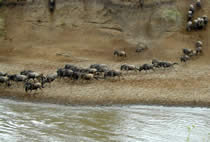
- HOME
- SERENGETI-MARA ECOSYSTEM
- WHY COUNT WILDLIFE?
- 1999 MARA COUNT
- 2002 MARA COUNT
- 2002 SUPPORTERS LIST
- 2002 SUPPORTING COMPANIES AND ORGANISATIONS
- WILDLIFE COUNTING METHOD
- DATA COLLECTED
- MASAI MARA MAPS
- ANALYSIS RESULTS
- GALLERY
- DOWNLOAD CENTRE
- DONATE HERE
- CONTACTS
- FURTHER REFERENCES
Serengeti Mara Ecosystem
Only 25% of the wildlife habitat in the Mara part of the ecosystem is protected (in the Mara Reserve); the rest lies within pastoral and agricultural areas north of the reserve.
Recent efforts to privatise land are also changing the way people have interacted
with wildlife over many millennia. Since the mid-1970s, these pressures have caused
a 60% decline in wildlife both inside and outside the Mara Reserve. |
 The
Serengeti - Mara Ecosystem supports the most diverse migration of grazing mammals
on earth. The Mara, although only a quarter of the total ecosystem area, is crucial
to the survival of the entire system because it is the source of forage for wildlife
migrating through the Serengeti during critical points in the dry season.
The
Serengeti - Mara Ecosystem supports the most diverse migration of grazing mammals
on earth. The Mara, although only a quarter of the total ecosystem area, is crucial
to the survival of the entire system because it is the source of forage for wildlife
migrating through the Serengeti during critical points in the dry season.  These
lands outside the reserve are also under more pressure than the rest of the ecosystem,
with recent unprecedented human population growth, expansion of wheat farming
in wildebeest calving grounds and expansion of tourism facilities.
These
lands outside the reserve are also under more pressure than the rest of the ecosystem,
with recent unprecedented human population growth, expansion of wheat farming
in wildebeest calving grounds and expansion of tourism facilities.